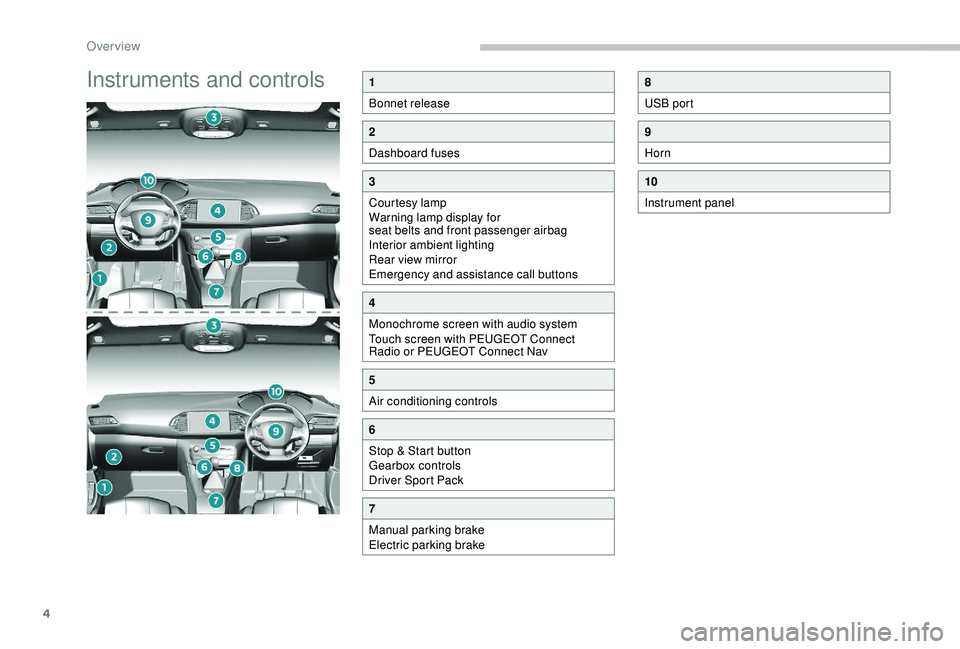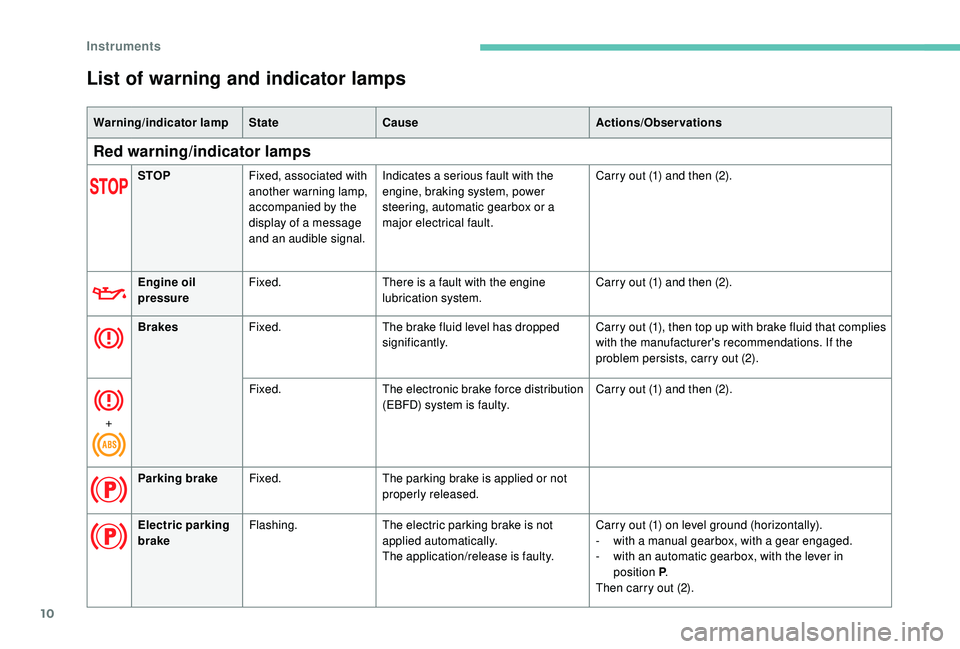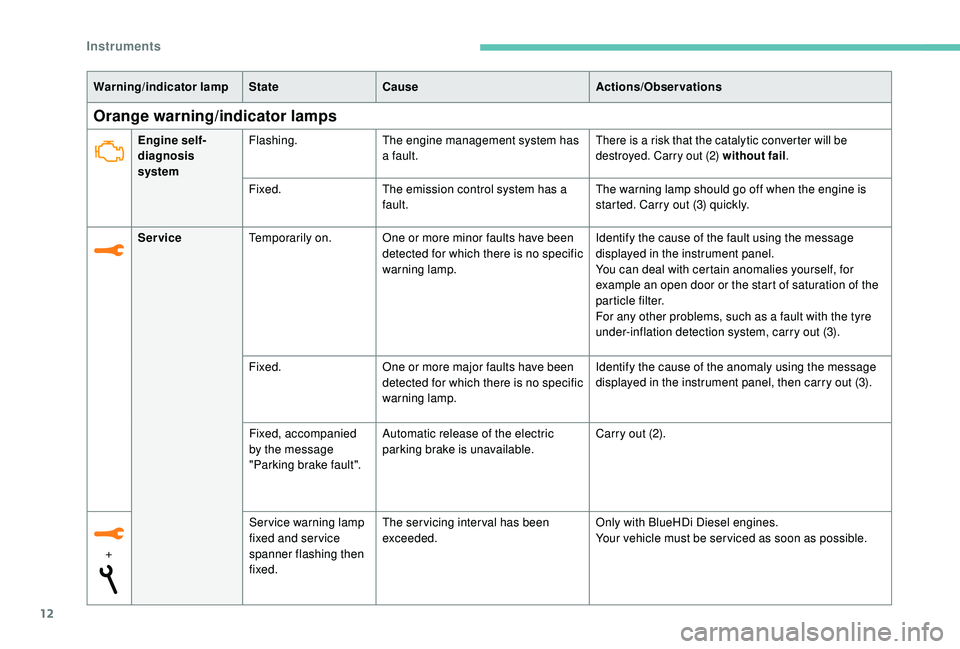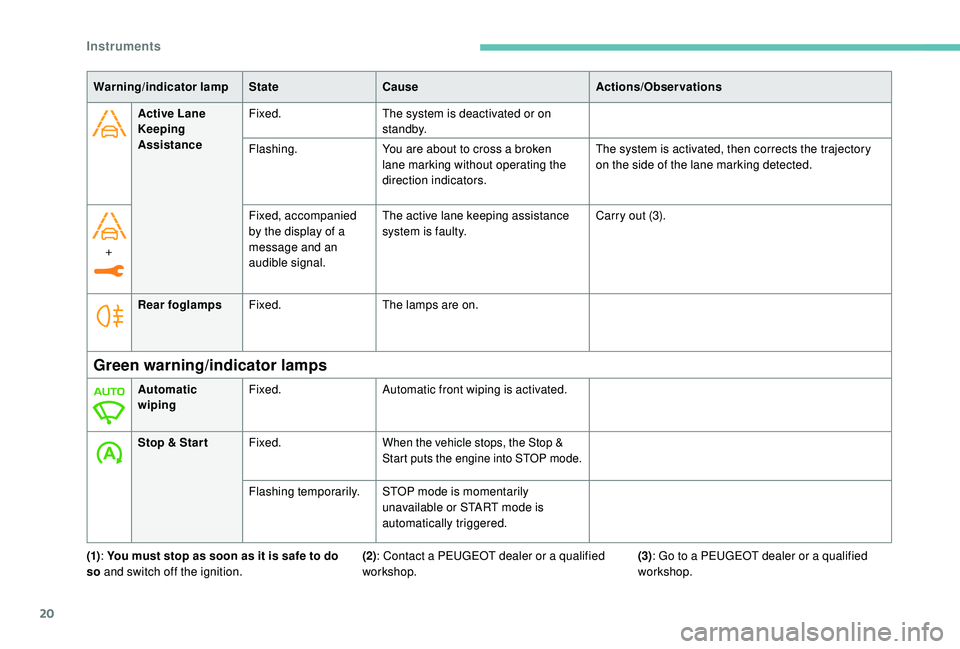2018 Peugeot 308 display
[x] Cancel search: displayPage 6 of 324

4
Instruments and controls1
Bonnet release
2
Dashboard fuses
3
Courtesy lamp
Warning lamp display for
seat belts and front passenger airbag
Interior ambient lighting
Rear view mirror
Emergency and assistance call buttons
4
Monochrome screen with audio system
Touch screen with PEUGEOT Connect
Radio or PEUGEOT Connect Nav
5
Air conditioning controls
6
Stop & Start button
Gearbox controls
Driver Sport Pack
7
Manual parking brake
Electric parking brake
8
USB port
9
Horn
10
Instrument panel
Over view
Page 8 of 324

6
As a passenger, if you avoid connecting your
multimedia devices (film, music, video game,
etc.), you will contribute towards limiting the
consumption of electrical energy, and so of
fuel.
Disconnect your portable devices before
leaving the vehicle.
Eco- driving
Optimise the use of your
gearbox
With a manual gearbox, move off gently
and change up without waiting. When
accelerating, change up early.
With an automatic or electronic gearbox,
favour automatic mode and avoid pressing the
accelerator pedal heavily or suddenly.
The gear shift indicator invites you to engage
the most suitable gear: as soon as the
indication is displayed in the instrument panel,
follow it straight away.
For vehicles fitted with an electronic or
automatic gearbox, this indicator appears only
in manual mode.
Drive smoothly
Maintain a safe distance between vehicles,
use engine braking rather than the
brake pedal, and press the accelerator
progressively. These practices contribute
towards a reduction in fuel consumption and
CO
2 emissions and also help reduce the
background traffic noise.
If your vehicle has cruise control, make use of
the system at speeds above 25
mph (40 km/h)
when the traffic is flowing well.
Control the use of your electrical
equipment
Before moving off, if the passenger
compartment is too warm, ventilate it by opening
the windows and air vents before using the air
conditioning.
Above 31
mph (50 km/h), close the windows and
leave the air vents open.
Consider using equipment that can help keep
the temperature in the passenger compartment
down (sunroof blind, window blinds, etc.).
Switch off the headlamps and foglamps when
the ambient light level does not require their
use.
Avoid running the engine before moving off,
particularly in winter; your vehicle will warm up
much faster while driving.
Unless it has automatic regulation, switch off
the air conditioning as soon as the desired
temperature has been reached.
Switch off the demisting and defrosting controls
when not required, if they are not automatically
controlled.
Switch off the heated seat as soon as possible.
Eco-driving is a range of everyday practices that allow the motorist to optimise their fuel consumption and CO2 emissions.
Eco-driving
Page 10 of 324

8
Instrument panel
Speedometer
Analogue speedometer (mph or km/h).
Coolant temperature and
fuel level indicators
1.Fuel gauge.
2. Engine coolant fluid temperature gauge.
Display screen
When travelling abroad, you may have
to change the distance unit: the display
of road speed must be in the official
units (miles or km) for the country. The
change of units is done via the screen
configuration menu, with the vehicle
stationary.
1. Engine oil level indicator.
2. Gear shift indicator.
State of the automatic gearbox.
3. Digital speedometer (mph or km/h).
4. Cruise control or speed limiter settings.
With display screen 2:
Instrument panel display screen:
-
G ear shift indicator.
-
S
tate of the automatic gearbox.
-
S
tate of the speed limiter or cruise control.
-
S
peed limit sign.
-
T
otal distance recorder.
-
T
rip distance recorder.
-
S
ervice spanner.
According to the page selected with the control
stalk (end of the wiper control stalk):
-
D
igital speedometer.
-
T
rip computer.
-
D
ynamic vehicle parameters (Driver Sport
Pack).
-
E
co mode.
-
D
riving aids.
-
R
epeat of the navigation instructions.
With display screen 1:
5.Ser vice indicator, then total distance
recorder (miles or km).
These functions are displayed successively
on switching on the ignition.
6. Trip distance recorder (miles or km).
Instruments
Page 11 of 324

9
Control buttons
A.General lighting dimmer.
B. Reset the trip distance recorder or the
ser vice indicator (according to context).
Rev counter
Rev counter (x 1,000 rpm).
Warning and indicator lamps
Associated warnings
The illumination of a lamp can be accompanied
by an audible signal and/or a message
displayed in a screen.
Relating the type of alert to the operating status
of the vehicle allows you to determine whether
the situation is normal or a fault has occurred:
refer to the description of each lamp for further
information.
When the ignition is switched on
Certain red or orange warning lamps come on
for a few seconds when the ignition is switched
on. These warning lamps should go off as soon
as the engine is started.
Persistent warning lamp
When the engine is running or the vehicle is
being driven, the illumination of a red or orange
warning lamp indicates a fault that needs
further investigation, using any associated
message and the description of the warning
lamp in the documentation.
Where a warning lamp remains lit
The references (1) , (2) and (3) in the warning
and indicator lamp description indicate whether
you should contact a qualified professional
in addition to the immediate recommended
actions.
(1) : You must stop as soon as it is safe to do
so and switch off the ignition.
(2): Contact a PEUGEOT dealer or a qualified
workshop.
(3) : Go to a PEUGEOT dealer or a qualified
workshop.
Temporary display:
-
S
er vice indicator (when the ignition is
switched on).
-
O
il level indicator (when ignition first
switched on, depending on version).
-
R
ange indicators related to the AdBlue and
to the SCR system.
-
A
lert messages.
With display screen
2 , pressing button
B briefly enables a manual CHECK to be
per formed (reminder of ser vice due date, the
driving range for the AdBlue and the SCR
system for BlueHDi versions and current
a l e r t s). Displayed as symbols, visual indicators
which inform the driver of the occurrence of a
malfunction (warning lamps) or of the operating
status of a system (operation or deactivation
indicator lamps). Certain lamps light up in
two ways (fixed or flashing) and/or in several
colours.
1
Instruments
Page 12 of 324

10
List of warning and indicator lamps
Warning/indicator lampStateCause Actions/Observations
Red warning/indicator lamps
STOPFixed, associated with
another warning lamp,
accompanied by the
display of a message
and an audible signal. Indicates a serious fault with the
engine, braking system, power
steering, automatic gearbox or a
major electrical fault.
Carry out (1) and then (2).
Engine oil
pressure Fixed.
There is a fault with the engine
lubrication system. Carry out (1) and then (2).
Brakes Fixed. The brake fluid level has dropped
significantly. Carry out (1), then top up with brake fluid that complies
with the manufacturer's recommendations. If the
problem persists, carry out (2).
+ Fixed.
The electronic brake force distribution
(EBFD) system is faulty. Carry out (1) and then (2).
Parking brake Fixed. The parking brake is applied or not
properly released.
Electric parking
brake Flashing.
The electric parking brake is not
applied automatically.
The application/release is faulty. Carry out (1) on level ground (horizontally).
-
w
ith a manual gearbox, with a gear engaged.
-
w
ith an automatic gearbox, with the lever in
position P .
Then carry out (2).
Instruments
Page 14 of 324

12
Orange warning/indicator lamps
Warning/indicator lampStateCause Actions/Observations
Engine self-
diagnosis
system Flashing.
The engine management system has
a fault.
There is a risk that the catalytic converter will be
destroyed. Carry out (2) without fail .
Fixed.The emission control system has a
fault. The warning lamp should go off when the engine is
started. Carry out (3) quickly.
Service Temporarily on. One or more minor faults have been
detected for which there is no specific
warning lamp. Identify the cause of the fault using the message
displayed in the instrument panel.
You can deal with certain anomalies yourself, for
example an open door or the start of saturation of the
particle filter.
For any other problems, such as a fault with the tyre
under-inflation detection system, carry out (3).
Fixed. One or more major faults have been
detected for which there is no specific
warning lamp. Identify the cause of the anomaly using the message
displayed in the instrument panel, then carry out (3).
+ Service warning lamp
fixed and ser vice
spanner flashing then
fixed.The servicing interval has been
exceeded.
Only with BlueHDi Diesel engines.
Your vehicle must be ser viced as soon as possible.
Fixed, accompanied
by the message
"Parking brake fault".
Automatic release of the electric
parking brake is unavailable.
Carry out (2).
Instruments
Page 18 of 324

16
Warning/indicator lampState CauseActions/Observations
+
+ SCR emissions
control system
Fixed when the ignition is switched
on, accompanied by an audible signal
and a message. A fault with the SCR emissions
control system has been detected.
This alert disappears once the
exhaust emissions return to normal
levels.
AdBlue® warning lamp flashing, on
switching on the ignition, associated
with the fixed Ser vice and engine
diagnostic warning lamps, accompanied
by an audible signal and a message
indicating the remaining driving range.Depending on the message
displayed, you can continue driving
for up to 685
miles (1,100 km) before
the engine starting prevention system
is triggered. Carry out (3) as soon as possible to
avoid breaking down
.
AdBlue
® warning lamp flashing,
on switching on the ignition,
associated with the fixed Ser vice and
engine diagnostic warning lamps,
accompanied by an audible signal
and a message. An engine immobiliser prevents
the engine from restarting (over
the authorised driving limit after
confirmation of a fault with the
emissions control system).
To restart the engine, carry out (2).
Distance Alert/
Active Safety
Brake * Fixed, accompanied by a message.
The system has been deactivated via
the vehicle configuration menu.
*
O
nly with display screen 2 .Flashing.
The system is operating.The vehicle brakes briefly so as to
reduce the speed of collision with the
vehicle ahead.
Fixed, accompanied by a message
and an audible signal. The system has a fault.
Carry out (3).
Instruments
Page 22 of 324

20
Active Lane
Keeping
AssistanceFixed.
The system is deactivated or on
st a n d by.
Flashing. You are about to cross a broken
lane marking without operating the
direction indicators. The system is activated, then corrects the trajectory
on the side of the lane marking detected.
+ Fixed, accompanied
by the display of a
message and an
audible signal.The active lane keeping assistance
system is faulty.
Carry out (3).
Rear foglamps Fixed. The lamps are on.
Green warning/indicator lamps
Automatic
wipingFixed.
Automatic front wiping is activated.
Stop & Star t Fixed.
When the vehicle stops, the Stop &
Start puts the engine into STOP mode.
Flashing temporarily. STOP mode is momentarily
unavailable or START mode is
automatically triggered.
Warning/indicator lamp
StateCause Actions/Observations
(1) : You must stop as soon as it is safe to do
so and switch off the ignition. (3)
: Go to a PEUGEOT dealer or a qualified
workshop.
(2): Contact a PEUGEOT dealer or a qualified
workshop.
Instruments